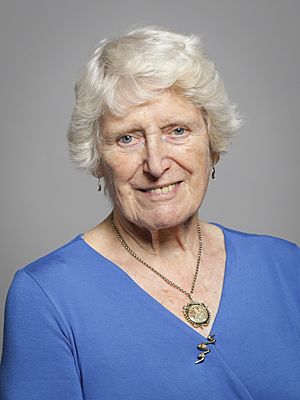Elizabeth Butler-Sloss, Baroness Butler-Sloss facts for kids
Quick facts for kids
The Baroness Butler-Sloss
|
|
|---|---|
 |
|
| President of the Family Division | |
| In office 1999 – April 2005 |
|
| Succeeded by | Sir Mark Potter |
| Lord Justice of Appeal | |
| In office 1988–1999 |
|
| Judge of the High Court | |
| In office 1979–1988 |
|
| Personal details | |
| Born |
Ann Elizabeth Oldfield Havers
10 August 1933 Buckinghamshire, England |
| Political party | None (crossbencher) |
| Other political affiliations |
Conservative Party (1950s) |
| Spouse |
Joseph William Alexander Butler-Sloss
(m. 1958) |
| Relations |
|
| Children | 3 |
| Parent |
|
| Residences | East Devon, Devon, England |
Ann Elizabeth Oldfield Butler-Sloss, Baroness Butler-Sloss, (born 10 August 1933) is a famous retired judge from England. She was a trailblazer for women in law. She became the first woman to be a Lord Justice of Appeal.
For a time, she was the highest-ranking female judge in the United Kingdom. This changed in 2004 when Baroness Hale was appointed to a higher court.
Butler-Sloss was also chosen to lead the official investigations, called inquests, into the deaths of Diana, Princess of Wales, and Dodi Fayed. She later stepped down from this role.
Contents
Early Life and Education
Ann Butler-Sloss was born in Buckinghamshire, England. Her father, Sir Cecil Havers, was also a judge. Her brother, Lord Havers, became a Lord Chancellor, one of the most important legal roles in the country. Her nephew is the well-known actor Nigel Havers.
She went to school at Wycombe Abbey School. After finishing school, she spent a year studying at the University of Lausanne in Switzerland. She became a lawyer without getting a university degree first, which was very impressive.
In the late 1950s, she tried to get into politics. She ran for office as a member of the Conservative Party but was not elected. After this, she focused on her career in law.
A Groundbreaking Legal Career
Becoming a Judge
Butler-Sloss became a lawyer, known as being called to the Bar, in 1955. In 1979, she made history by becoming the fourth woman ever to be appointed a High Court judge in England. All female High Court judges at that time were assigned to the Family Division, which handles cases about families and children.
When she became a judge, she was also given the title of Dame Commander of the Order of the British Empire (DBE), a special honour from the Queen.
Reaching the Highest Courts
In 1988, Butler-Sloss broke another barrier. She became the first woman ever to be a Lord Justice of Appeal. This meant she was a judge in the Court of Appeal, one of the most senior courts in the country. Before this, she had led a major investigation into how to better protect children.
In 1999, she became the President of the Family Division of the High Court. She was the first woman to hold this job. This made her the most senior female judge in the UK at the time.
In 2005, she received an even higher honour, the Dame Grand Cross of the Most Excellent Order of the British Empire (GBE). She retired from her role as President of the Family Division in the same year.
Life in the House of Lords
In 2006, Butler-Sloss was made a Baroness and given a life peerage. This means she has a seat in the House of Lords, the second house of the UK Parliament. She sits as a crossbencher, which means she does not belong to any political party. This allows her to vote based on her own judgment.
In the House of Lords, she has been part of many important committees. These groups study new laws and big issues. For example, she has been the head of the Ecclesiastical Committee, which deals with laws related to the Church of England.
Personal Life
In 1958, she married Joseph William Alexander Butler-Sloss. Together, they had three children.
Baroness Butler-Sloss is a member of the Anglican church. Her faith is important to her. In 2002, she was in charge of the committee that helped choose the new Archbishop of Canterbury, the leader of the Church of England.
See also
- Ms B v An NHS Hospital Trust

